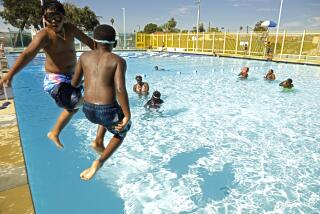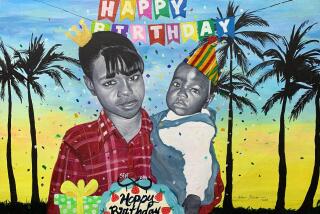Birthdays: No Longer a Piece of Cake
- Share via
In the children’s book “The Berenstain Bears and Too Much Birthday,” Sister Bear dissolved into tears at her 6th birthday party, undone by games she couldn’t win, candles that wouldn’t blow out and a merry-go-round that upset her stomach.
Clearly, she was the victim of “too much birthday.”
Children can, indeed, suffer from too much birthday. So can their parents. As the Bear family discovered, it’s an easy malady to fall prey to.
An Early Start
One party is hardly over when a child begins to plan his next birthday. Indeed, it is not unusual for a preschooler to start talking about “my birthday” without provocation, even though it is months away.
Birthday parties are so important to these youngsters that invitations are the carrots and sticks of nursery school: “You can’t come to my birthday” is perhaps the most dreaded cry among preschoolers.
Parents, too, can get caught up in this birthday craziness, wanting to please their child--whether he be 6 or 16--even more than last year, or to please themselves with a party more elaborate than the neighbor’s.
Some parents are aware of this tendency for one-upmanship and arduously guard against it. It was with great apology that a neighbor explained before his daughter’s 4th birthday party that he was not trying to start any “birthday party wars,” but that a friend who works at the zoo had volunteered to bring some small animals for the children to see and pet.
These days, at least for many parents, there is more to birthday parties than a cake and party hats.
Gone are the days when a child had a kid-party only a few times before he was 18; other years, Mom would cook his favorite meal, wrap the presents and invite the grandparents for ice cream and cake.
Now, children’s parties are annual happenings in most houses. Many people attribute this to the lack of close-by extended families, meaning there’s no one extra special to come for ice cream and cake.
A Headache Starter
Whatever the causes, birthday parties have become big business and, in some cases, big headaches.
But they don’t have to be.
“The planning has to be thorough and the communication has to be good,” said Bea Badders, who has taught preschoolers and parenting classes in this area for many years.
“Be sure your own child understands what’s going to happen,” especially concerning gifts, she said, adding that parents should establish a place to put gifts and tell youngsters when they can open them.
Communication also has to extend to parents of guests, she added. “You have to be very specific when the party starts and when you want the children to be picked up.”
Match the party to the birthday child’s age. Age governs how many children to invite, how long the party will last and what activities to arrange.
When a child turns 1, writes Marguerite Kelly in “The Mother’s Almanac,” he needs only “his doting family and perhaps one young guest, the ‘Happy Birthday song,’ a little help blowing out the candle and then the cake itself, placed right on his high-chair tray. You can expect him to burrow into the icing with two hands and a face.”
After that, parties get a little more complicated. Have as many children as your child is years old, Kelly said.
A Liberal Approach
Charles and Linda Kraus, in their book, “Charles the Clown’s Guide to Children’s Parties,” are more liberal. Three-year-olds can handle eight to 10 guests with the number building slowly, they said.
As for the party itself, parents’ expectations should not be too high. “It never turns out exactly the way you planned it,” Badders said from experience.
If, in fact, parents harbor a dream birthday, they had better plan it for a child’s first, when the baby doesn’t care what goes on. After that, most children are savvy enough to know what kind of party they want, and bold enough to ask for it.
Parents can use this to their advantage. The older the child, the more he can help. Teen-agers, in fact, can do almost all the planning and much of the preparation.
Fire Up the Grill
For parents unsure of how to entertain a group of young children, a meal may be the answer. It need not be elaborate. Sandwiches--cheese, peanut butter and jelly, tuna--and a few go-alongs are enough. Parents can even move the party outdoors, fire up the grill and serve hot dogs and hamburgers. What child would be disappointed?
There are a variety of entertainers--clowns, magicians, fortune tellers, face painters, puppeteers, crafts people--who can liven up the party. One bit of advice: Costumed characters often frighten youngsters under 3, said Ann Thomas, who has operated Ann’s Kids Shows for 16 years.
Children’s parties, like adults’, often start slowly. The child who was bouncing off the wall at 1:45 p.m. may be hiding in the folds of his mother’s skirt at 2:05. The guests, too, may be afflicted with the shys. Music and an activity are ways to get the party moving until all the children arrive.
Don’t forget to record the party. One idea: Ask each child to draw a picture for the birthday child, then turn the art into a booklet, Badders said. From year to year, a child can remember who came and what they created. Parents also can mark the growth of their child through the increasing skill and sophistication of the guests’ creations.
Birthdays are, after all, celebrations of growth and change. It’s good to be able to look back and see how far a child has come since the last cake and craziness.
More to Read
Sign up for Essential California
The most important California stories and recommendations in your inbox every morning.
You may occasionally receive promotional content from the Los Angeles Times.










